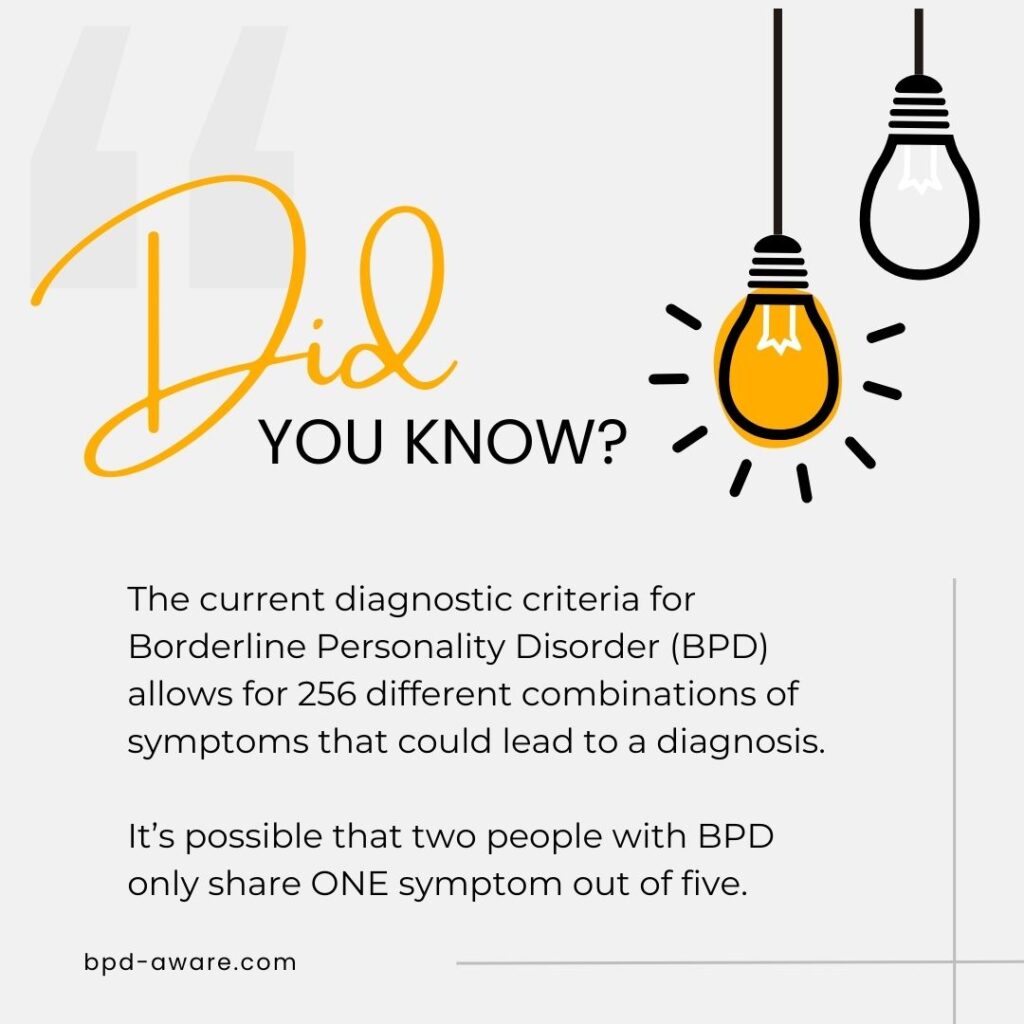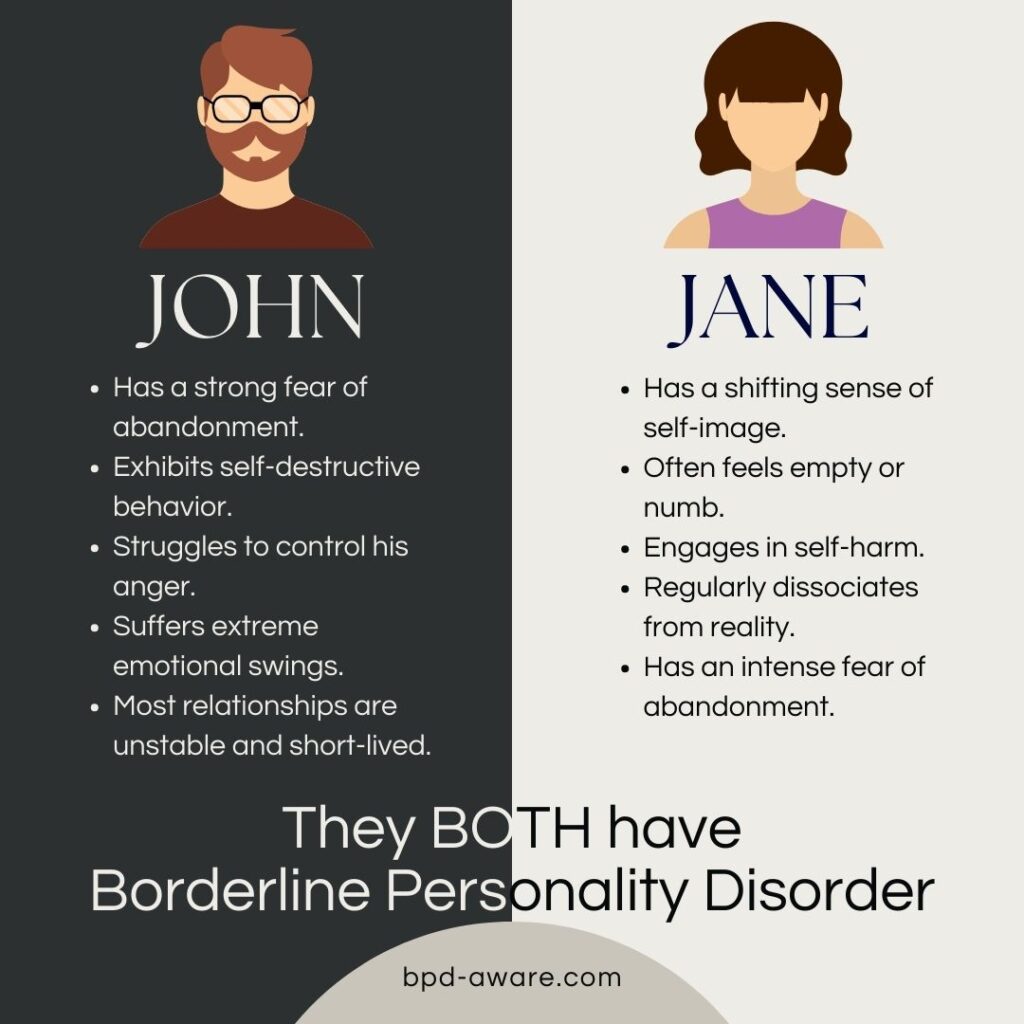Borderline Personality Disorder (BPD) is a complex disorder that still requires a lot more research for us to better understand it. One of the most interesting theories posits that BPD may exist on a spectrum.
When people first hear spectrum, their mind often turns to autism – a developmental disorder – which uses the term. There has been some confusion when people theorize that BPD may exist on a spectrum which means it’s related to Autism. This is a misconception.
When it’s said that BPD may exist on a spectrum, it simply means that there are a range of symptoms, behaviors, and conditions that vary in severity and how they present themselves. They do, however, share common features.
Understanding Borderline Personality Disorder and its Varieties
It’s commonly accepted that BPD has nine core symptoms, of which you need five or more to be diagnosed. Those symptoms are:
- Fear of abandonment.
- Unstable interpersonal relationships.
- Unstable sense of identity.
- Impulsive behavior.
- Self-harming or suicidal ideation or behavior.
- Rapid mood swings.
- Chronic feelings of emptiness.
- Anger management issues.
- Paranoia or dissociation.
According to people much better at math than I am, that creates 256 combinations of symptoms by which someone could receive a BPD diagnosis.
Then there are the four subtypes of BPD: Self-Destructive, Impulsive, Petulant, and Quiet/Discouraged. (Click the links to find a detailed description of each subtype of BPD)
While these subtypes all share a combination of the nine symptoms, they often vary in the way these symptoms present themselves and how severe certain symptoms of BPD are. People with BPD may fit into one or more of these subtypes at any one time and also shift between subtypes throughout their lives.
BPD can also be classified in terms of severity from mild, to moderate, all the way up to severe in terms of how much it’s affecting the sufferer’s life. Much like subtypes, it’s thought that someone with BPD can shift between severity levels throughout their life. For example, someone with mild BPD could swing to moderate or even severe BPD due to an external stressor. Or, on a more positive note, someone with severe BPD could work their way down the scale to mild BPD (and eventually be considered BPD-free) thanks to therapy, a strong support network and things generally going well in life.

BPD and the Spectrum
The definition of a spectrum when it (comes to mental health) states that symptoms and characteristics can change over time, vary in severity, and exhibit diverse combinations and patterns across individuals. I think, by that definition, BPD is certainly on a spectrum, given what has already been stated.
Just from my own experiences with BPD, I can confidently say there was a great deal of spectrum-like shifting in my symptoms and how they presented throughout my life. Likewise, the variety of experiences and presentations of people I met in group therapy were countless. I hate to use the term “snowflake” given its recent negative connotation but truly no two experiences were alike in any of the people I shared group therapy with. Despite the wide variety, I never doubted for a second that any of us had Borderline Personality Disorder.
Now, before I declare for certain that BPD is on a spectrum (something I certainly don’t have the power to do), I’d like to look at the flip side of the coin.
The opposite of a spectrum in regards to a personality disorder would be having clear-cut boundaries and guidelines, much as BPD is diagnosed now. This is rather ironic when one of the components of BPD is a propensity for black-and-white thinking. However, such a black-and-white view does have its uses.
The Clear-Cut Approach to BPD
There are concerns that if BPD were to be classified officially as a spectrum disorder it could feel invalidating to people with Borderline Personality Disorder and the suffering their disorder has caused.
If you were to tell someone you are considered to be low-to-medium on the BPD spectrum, this can make it sound much less serious than it is. Likewise, the general population with a small amount of knowledge of the disorder may then consider themselves on the BPD spectrum because they have one of the traits. A little knowledge can be a dangerous thing! Suddenly, someone believes they have a condition and it’s just as problematic as someone with a genuine disorder.
If BPD were to be recognized officially as being on a spectrum, it would still require boundaries and guidelines, just like in Autism Spectrum Disorder (ASD). These guidelines would be incredibly tricky to define and would require care, time, and research.

The Future of BPD and the Spectrum
Would it surprise me if BPD was reclassified as a spectrum disorder? No. I can certainly see a future where BPD is reclassified and split into several types, much like how ASD has Asperger’s Syndrome, Kanner’s Syndrome, Rett Syndrome, Childhood Disintegrative Disorder and Pervasive Development Disorder Not Otherwise Specified.
I imagine though that with the sheer varieties of symptoms, subtypes, and severity this would be an arduous task and require a large number of new classification types. But that’s not to say such a move would be without merit. If it helps people receive a more accurate diagnosis and a more personalized treatment plan, then that’s a fantastic result.
However, great care must be taken not to marginalize and invalidate those of us who’ve already received a BPD diagnosis.
Final Thoughts
Borderline Personality Disorder is doubtlessly a complex and serious condition. The symptoms, severity, and subtypes all point to the fact that BPD is experienced on a spectrum, and quite a wide one at that. Yet, despite this, a set of guidelines for diagnosis still requires some level of black-and-white thinking.
While the Diagnostic and Statistical Manual currently sees BPD as a “yes-or-no” proposition, that may change over time. Certainly, many sufferers of BPD believe that the condition is indeed on a spectrum.
Should there be a shift of thinking on an official level, there would be benefits and drawbacks.
The stigma that undoubtedly still surrounds BPD could swing one of several ways. Perhaps it would become more accepted if more people considered it as a spectrum and that how BPD presents can vary wildly from person to person. There is, however, the risk that BPD is taken less seriously by the general populace, which would hurt those with BPD, especially the more severe cases.
Treatment may become more personalized and (hopefully) more successful as a result. This would be the biggest positive that could come from a change in thinking about BPD.
But enough about what I think. What do YOU think about BPD existing on a spectrum? Leave a comment in the box below.
Sources, Resources, and Further Reading
- Point of View: Not All Borderline Personality Disorder is Alike: https://www.psychiatrist.com/news/viewpoint-not-all-borderline-personality-disorder-is-alike/
- Is BPD on a Spectrum? Diagnostic Criteria & Recovery Experiences: https://elizablooms.com/2024/01/21/is-bpd-on-a-spectrum-diagnostic-criteria-recovery-experiences/
- Is BPD a Spectrum?: https://www.reddit.com/r/BPD/comments/17ef3w1/is_bpd_a_spectrum/
















